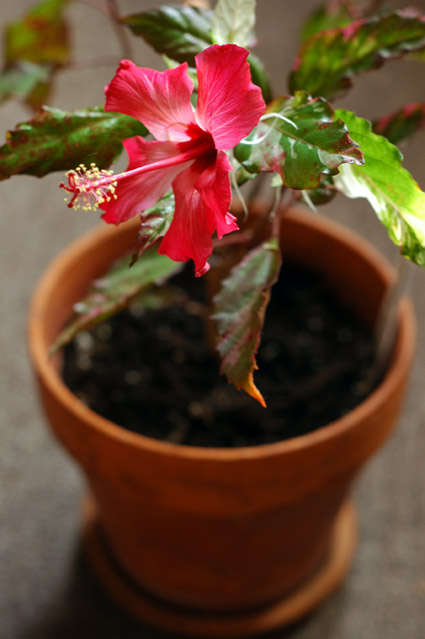
I bought this Hibiscus rosea plant back in May at the Parkdale Horticultural Society Annual Plant Sale. At the time the plant was a wee cutting but just today it opened its first bloom with two buds on the way. I generally dislike the over-bearing tackiness and waxy leaves of tropical hibiscus plants, reserving my interest for ‘Red Burgundy’ okra, a relation that produces delicious fruit and beautiful, yellow flowers with crimson centers. The delicacy of the Hibiscus rosea plant and its’ pretty variegated foliage (white and green with pink splashes) is what drew me in, and, well, the frantic nature of the plant sale is very conducive to out-of-character impulse buys.
The tag states that the plant has variegated foliage with pink flowers but I would describe the flower more closely as shades of red. It has a dark red spot in the center, gradating from light pink to pale red along the edges. Don’t be fooled by the photo, my plant is only 12″tall with 3″ wide flowers. Isn’t it cute? And with its red, white, and green coloration it makes a slightly-less-than-typical change from the usual holiday season plant fare.
okra is related to hibiscus? i learnt something today… :)
Yep. I posted a photo here
What?? How did I not know this??
I think this is the most interesting and surprising botanical fact I’ve heard so far. Now I definitely have to use those okra seeds I have this spring! The flowers are so pretty!
Well I observed the first time I grew okra that the flowers looked a whole lot like hibiscus. Then I looked it up and they have two botanical names (Hibiscus esculentus) or (Abelmoschus esculentus). …So shared genus and family. You’ll notice though that the ‘Red Burgundy’ okra flower looks a lot closer to this palmate-leaved hibiscus. If you’ve ever grown okra you’ll also notice that it can get quite a woody stem and can grow to be quite tall depending on the variety.
I LOVE these kinds of discoveries. A lot of gardening is just observation.
Just wanted to add that you can really see that it is in the mallow family with other flowers like hollyhock and definitely cotton. I found cotton growing on a beach in Mexico years ago and it had a similar look about it. The plant looked different… although okra has spines just like cotton.
Okay because you gals are totally inspiring the geek in me to rise up (it doesn’t take much prodding), here’s an interesting link to some okra history. The Ethiopian background is fascinating. I did not know that the woody pods (left on the plant) are made into rope and paper!
Thanks for the links Gayla. Very interesting history from such a tasty fruit (uh, botanically speaking) that I have loved for so long and not known a darn thing about! Here I thought I had already scoured the seas of botanic facts and found all the surprising information that there was to find, but you have convinced me that I have yet to scratch the surface.
On another note, isn’t it amazing what you can use to make paper? I think they used to make paper out of old linen rags before they switched to wood pulp!
And plants like agave makes sisal rope (cordylines make great rope too).
Yes, it is the wonder of the plant world.
I should write about a great book I have that is all about making paper with garden plants.
I think you should. I might have to read it.
I see you said you are not a huge fan of tropical hibiscus, but I would challanger anyone to view the hibiscus plants on http://www.strictlyhibiscus.com and not fall in love with at least one of them. The bright colors are trully amazing!